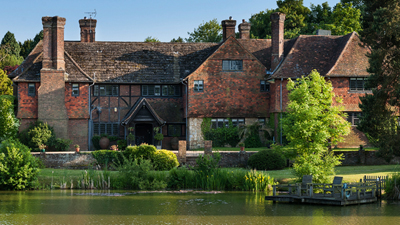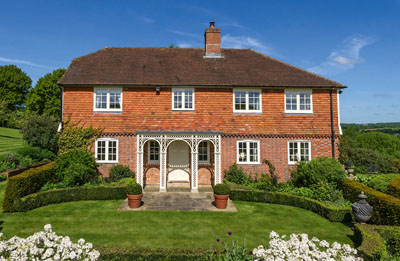Idyllic houses under an hour from London
The countryside idyll with an easy commute- that's the dream, and it's an achievable one


And of the substantial premium buyers will pay for a dream country property, even in difficult times. For sale through Strutt & Parker (020-7629 7282) at a guide price of £7.95 million, historic, Grade II listed Woodmancote Place - a mile from Henfield, West Sussex, and 48 miles from central London-has everything a buyer could wish for: a fine historic house in a picturesque setting, glorious views and total privacy.
Set in 149 acres of lakeside gardens and grounds, pasture, deer park and woodland, the house, first mentioned in records of 1339 and 1434, has evolved over time around the core of a late-medieval stone building, of which only one storey survives, with an early-17th-century, timber-framed first floor above it.

Woodmancote Place, £7.95m, Strutt & Parker
According to its listing, the south parlour was rebuilt in the early 1700s as part of a new five-bay range running eastwards, and the entire house was refaced in about 1920, and extended to the east, west and north, in the revived Sussex Vernacular style, par timber-framed and part tile-hung. The park, restocked with deer by the current owners, who bought Woodmancote Place in 2002, was established in the late 19th century; the gardens around the house were laid out by Cheals of Crawley in 1923. As the chief manor house of the village, Woodmancote Place has had its share of famous-and infamous-owners.
In 1530, Woodmancote passed to Catherine, wife of Sir Edward Seymour, later Earl of Hertford and 1st Duke of Somerset, who was executed for treason in 1552. In 1531, Seymour sold the manor to Richard Bellingham, whose widow married George Goring, described as lord of the manor in 1560. For 200 years from 1693, the estate was owned by the industrious Dennett family, who extended the house and increased the farmland to 402 acres by 1840.
** Subscribe to Country Life; Country Life on Ipad
Between the wars, Lt-Col R. W. McKergow was lord of the manor, but by 1946-47, Woodmancote was owned by Thomas Dennett, who was, presumably, related to its former owners. The house was sold a number of times after that, becoming a stud farm in the 1980s and then a country club, before the present owners completed the rehabilitation of the house and grounds. Approached along a magnificent tree-lined drive, elegant Woodmancote Place has reception and inner halls, three charming main reception rooms, a superb kitchen/ breakfast room, family rooms, 10 bedrooms and seven bath/shower rooms.
Sign up for the Country Life Newsletter
Exquisite houses, the beauty of Nature, and how to get the most from your life, straight to your inbox.
‘Having sold Winters Farm near Mayfield twice in my career, I was determined not to lose it when it came to the market again 10 years ago,' says country estate agent Anthony Brooks, who admits to paying over the odds for his piece of East Sussex heaven.
The former dairy farmhouse was extended and refurbished in 2000 by the well-known local architect Stephen Langer, but for Mr Brooks, the property's main attraction is its impregnable position between two historic estates, Wadhurst Park and the Glynde estate. But he now wants to downsize, and his Sussex retreat is on the market through Batcheller Monkhouse (01892 512020) and Knight Frank (01892 515035) at a guide price of £2.25m.

Winter's Farm, £2.25m, Knight Frank
Winters Farm stands in five acres of manicured gardens, pasture and woodland at the end of a long private drive, two miles from Mayfield, with spectacular views in all directions. And with mainline stations at Stonegate, Wadhurst and Tunbridge Wells a short drive away, it offers total privacy without being isolated. The main house has three reception rooms, a large kitchen/ breakfast room, five bedrooms and three bathrooms. During his tenure, Mr Brooks has tastefully converted a courtyard of traditional farm buildings to a one bedroom cottage, a home office and garaging for three cars.

The Paley Estate, £9.5m, Chesterton Humberts
As one door closes, another one opens with the sale, for the first time in almost 100 years, of the 441-acre Paley farming estate near Cranbrook, Kent- as a whole or in 18 lots-at a guide price of £9.5m through Chesterton Humberts (020-7594 4746).
The farm was bought by James Day in 1917, and passed down through the family to his grandson, Jim, who died in 2012. Shades of The Darling Buds of May, Paley enjoyed its farming heyday before the Second World War, when fruit and hops were the mainstay of the business. The Agricultural Census Return for 1940 shows a labour force of 22 full-time men and 29 part-time women, with a further 20 taken on for fruit picking and 400 more-mainly East Enders on working holidays-employed for hop-picking. The late Jim Day, a talented gardener, took over the farm in the early 1960s, but fruit- and hop-growing declined after Britain joined the Common Market in 1973, and, in the late 1990s, Mr Day retired and rented out the farm.
So far, much interest has been focused on the estate's substantial portfolio of residential property, which includes the impressive, Grade II-listed, five-bedroom farmhouse set in two acres of gardens, 11 modern and period cottages previously used to house farm workers and numerous traditional farm buildings with obvious development potential.
The land, which has glorious views over a particularly lovely part of rural Kent, includes some 293 acres of grassland, 46 acres of apple and pear orchards, and 93 acres of amenity woodland, with all sporting rights in hand.
* Follow Country Life property on Twitter
-
 Two quick and easy seasonal asparagus recipes to try this Easter Weekend
Two quick and easy seasonal asparagus recipes to try this Easter WeekendAsparagus has royal roots — it was once a favourite of Madame de Pompadour.
By Melanie Johnson Published
-
 Sip tea and laugh at your neighbours in this seaside Norfolk home with a watchtower
Sip tea and laugh at your neighbours in this seaside Norfolk home with a watchtowerOn Cliff Hill in Gorleston, one home is taller than all the others. It could be yours.
By James Fisher Published
